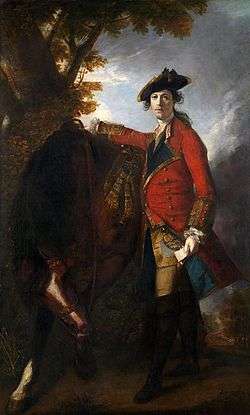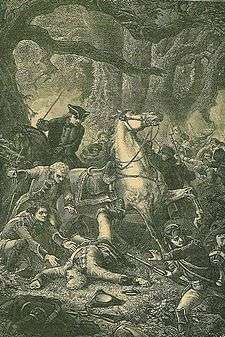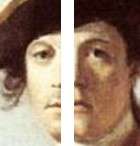Robert Orme (soldier)


Robert Orme (c.1725 – 1781 or 1790) was a British soldier who took part in the Battle of the Monongahela in July 1755, at the beginning of the French and Indian War, during which he was shot. He served with the young George Washington, with whom he became friends, and soon after his return to England in 1755 was painted by Joshua Reynolds.
Early life
Robert Orme was born around 1725.[3] His family origins are unknown but he is not thought to have been of aristocratic birth.[4]
Career
Orme entered the British army as an ensign in the 35th Regiment of Foot but transferred to the Coldstream Guards in 1745. He became a lieutenant in that regiment in 1751.[5]
By the time of the French and Indian War, Orme was aide-de-camp to General Edward Braddock. Although officially a lieutenant, he became a brevet captain and was known as Captain Orme.[1] Also serving as an aide to Braddock was George Washington who wished to acquire military experience and with whom Orme became friends.[6]
In 1755, Braddock was engaged in a push by British and American forces towards Fort Duquesne, in what is now Pittsburgh in Pennsylvania, which was held by French opposing forces. In July that year, Braddock's army was decisively ambushed by a smaller French and native Indian force in the Battle of the Monongahela with the loss of nearly 900 British and American soldiers. Braddock was mortally wounded and Orme shot in the leg. Some of the dead were scalped by the Native American allies of the French and their scalps nailed to trees in order to terrify the British. Orme escaped in the disorderly retreat and returned to England in 1755, becoming something of a celebrity as a survivor of the massacre.[3] He resigned from the army in 1756.[1]
Orme's account of the campaign was published in 1856 in an edition edited by Winthrop Sargent of the Historical Society of Pennsylvania.[4]
Portrait by Joshua Reynolds
In 1756, Joshua Reynolds painted Orme in the uniform of the Coldstream Guards in a scene referring to the defeat at Monongahela. Orme is shown with his horse in a darkened corner of a forest in front of an appropriately stormy sky with the battle continuing behind him, the red jackets of the British visible through the trees.[3] According to the National Gallery, the composition of the painting was based on a sketch of Saint Francis embracing a Sick Man completed by Jacopo Ligozzi in 1752.[1]

Reynolds's division of Orme's face into light and dark halves has been noted by critics for its insight into the effect on Orme of the battle and the loss of comrades. Mark Hallett describes the light half as showing a "resolute and reassuring English army officer", while he sees the dark half as showing a man who only minutes before had seen his comrades "cut to pieces", as it was put in contemporary newspapers.[3]
Douglas Fordham agrees and describes the painting as an innovative work that updates the established genre of the full length portrait, which was typically of an aristocrat born to his position, to include a display of the sensibility expected of a gentleman in the 18th century, and to show a man who had achieved his position through his own talents, like Joshua Reynolds who also was not from an aristocratic background. In that respect, Fordham argues, Orme was symbolic of a changing England where merit was beginning to matter more than connections, both in soldiering and in painting.[7]
Hallett places the picture in the genre of portraits of martial celebrities that developed in England in the eighteenth century against a background of the Seven Years' War (1755–1764) and other conflicts during the century, and which was one of the genres in which Reynolds specialised. He also describes the Orme portrait as exemplifying Reynolds's desire to go beyond simple likeness in order to comment more generally on developments in British society, in this case British military ambitions and the anxieties provoked by war.[3]
The painting may have been made speculatively without a buyer in mind as Reynolds did not sell it until 1777 when it was acquired by the 5th Earl of Inchquin. It passed by descent to the 5th Earl of Orkney before it was bought by Sir Charles Eastlake at Christie's in 1862[1] or 1863[3] for the National Gallery.
Family
After his return to England, Orme resigned his commission in the army[8] and eloped with Audrey Townshend (died 1781),[9] the only daughter of Charles Townshend, 3rd Viscount Townshend of Raynham and his wife Audrey, Lady Townshend.[4]
Death
Orme died in 1790 according to modern sources,[3] or in February 1781 according to a source published in 1856.[4]
See also
References
- 1 2 3 4 5 Captain Robert Orme. National Gallery. Retrieved 5 May 2016.
- ↑ Major-General Braddock's death at the Battle of Monongahela, 9 July 1755. Canadian Military History Gateway. Retrieved 6 May 2016.
- 1 2 3 4 5 6 7 "Robert Orme 1756" by Mark Hallett in Martin Postle (Ed.) (2005) Joshua Reynolds: The creation of celebrity. London: Tate Publishing. pp. 89 & 96. ISBN 1854375644
- 1 2 3 4 "Captain Orme's Journal" by Robert Orme in Winthrop Sargent (Ed.) (1856) The history of an expedition against Fort Du Quesne, in 1755; under Major-General Edward Braddock &c. Philadelphia: J.B. Lippincott. pp. 281–358.
- ↑ A list of the general and field-officers, as they rank in the army &c. London: J. Millan. 1756. p. 30.
- ↑ Clary, David A. (2011). George Washington's first war: His early military adventures. New York: Simon and Schuster. p. 133. ISBN 978-1-4391-8112-6.
- ↑ Fordham, Douglas. (2010). British art and the Seven Years' War: Allegiance and autonomy. Philadelphia: University of Pennsylvania Press. p. 69. ISBN 978-0-8122-4243-0.
- ↑ Fordham, p. 268.
- ↑ "Townshend, Etheldreda, Viscountess Townshend (c.1708–1788)" by John Martin in Oxford Dictionary of National Biography, Oxford University Press, 2004. Online edition, Jan 2008. Retrieved 6 May 2016.